2022年中考英语辨析系列-- (4)代词正误速辨
文档属性
| 名称 | 2022年中考英语辨析系列-- (4)代词正误速辨 | 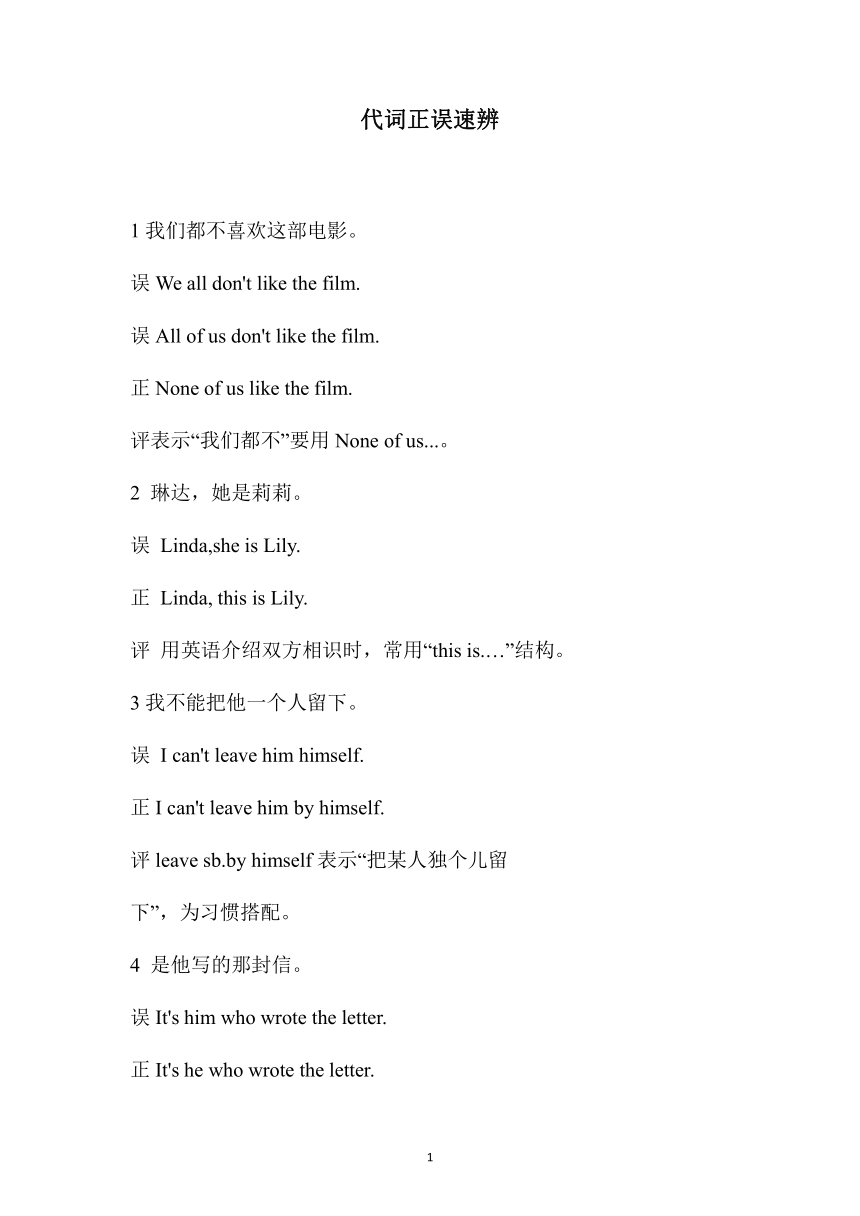 | |
| 格式 | docx | ||
| 文件大小 | 22.8KB | ||
| 资源类型 | 教案 | ||
| 版本资源 | 通用版 | ||
| 科目 | 英语 | ||
| 更新时间 | 2022-02-28 21:03:53 | ||
图片预览

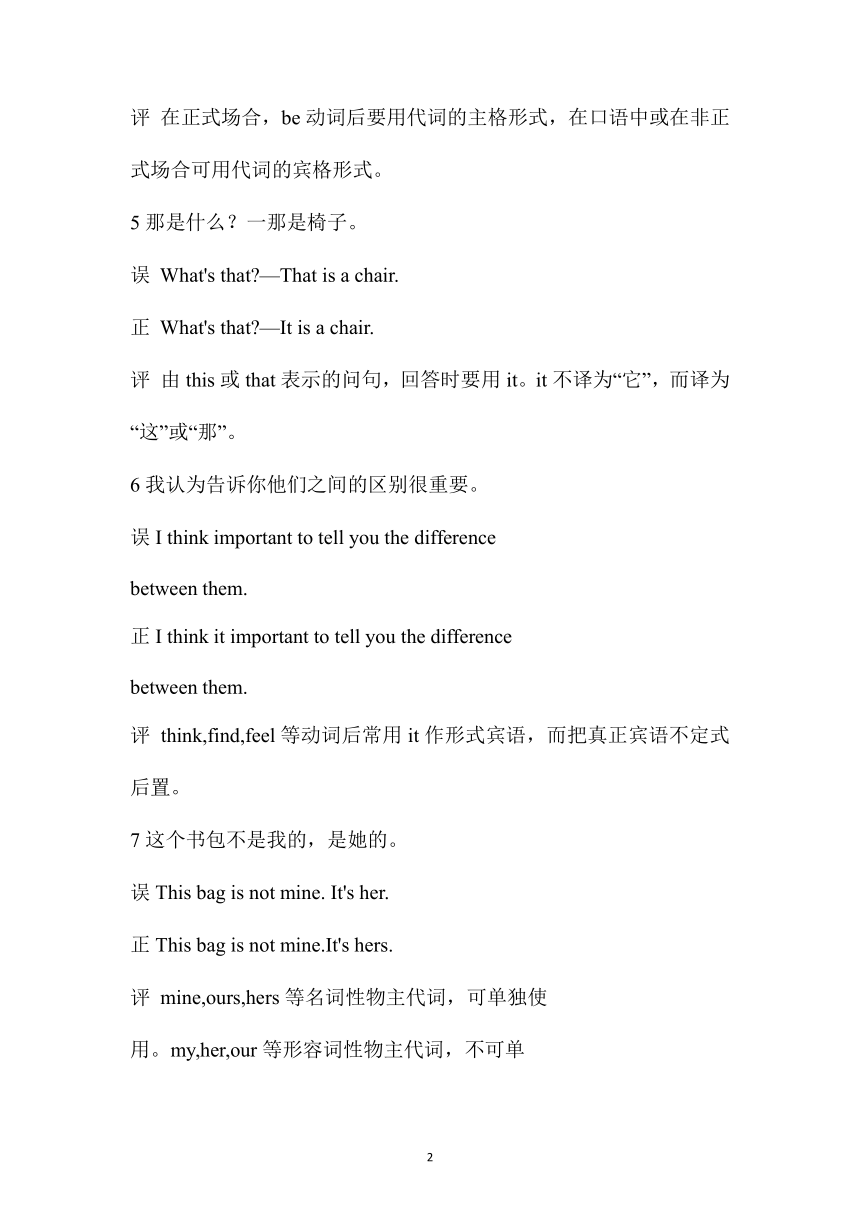
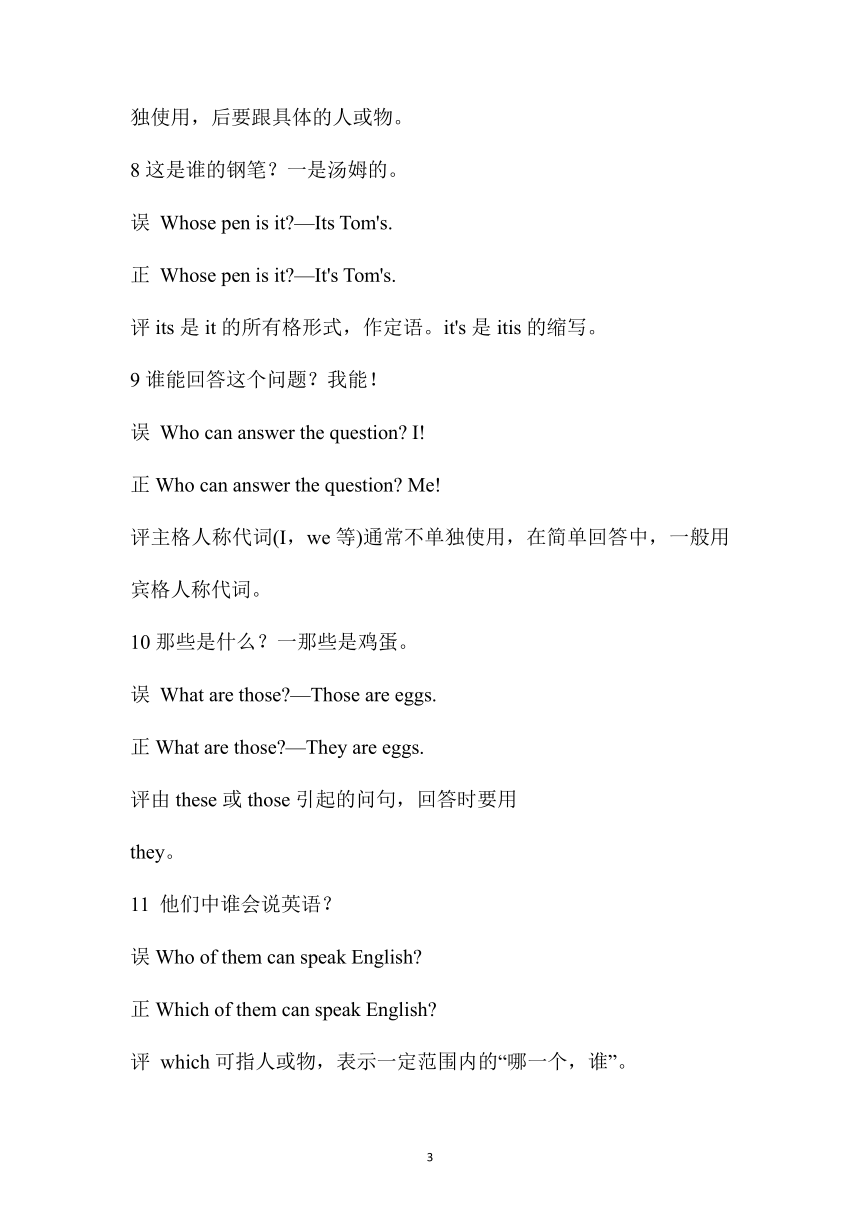
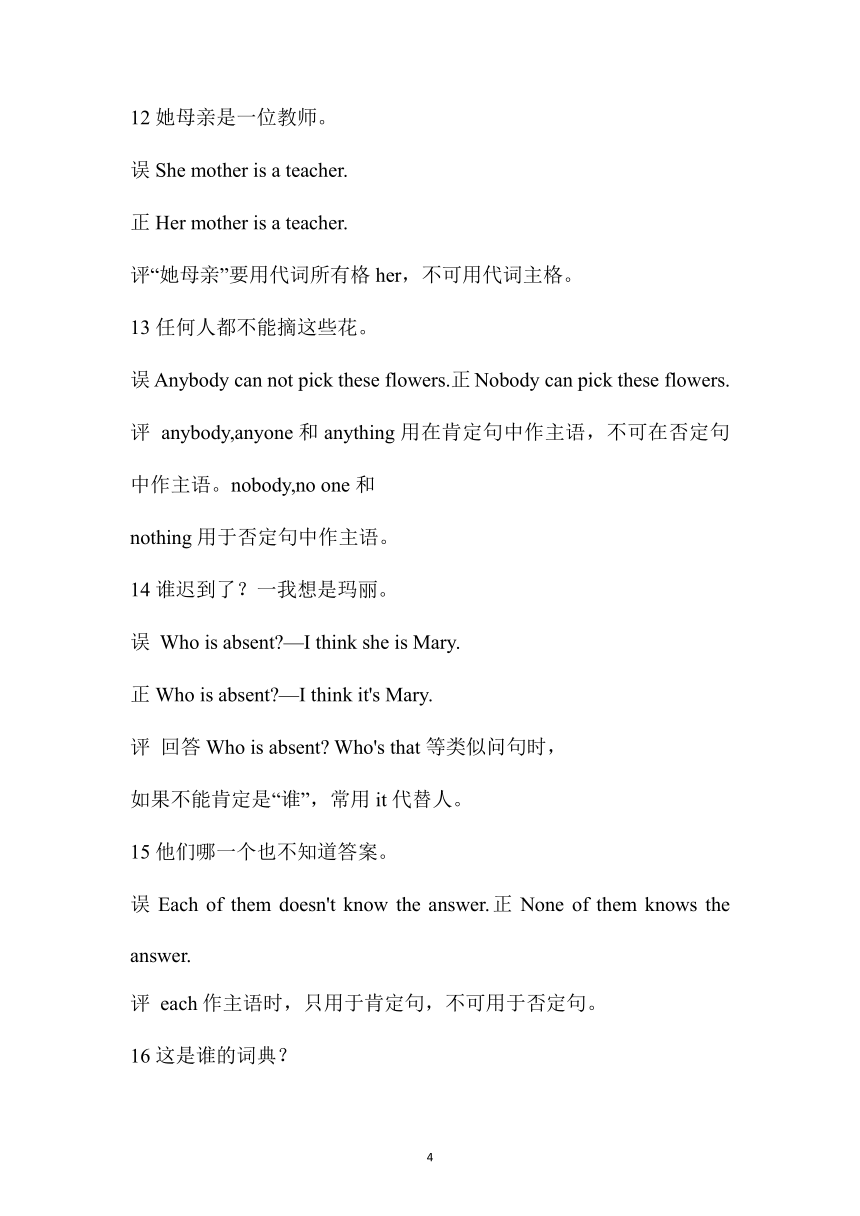
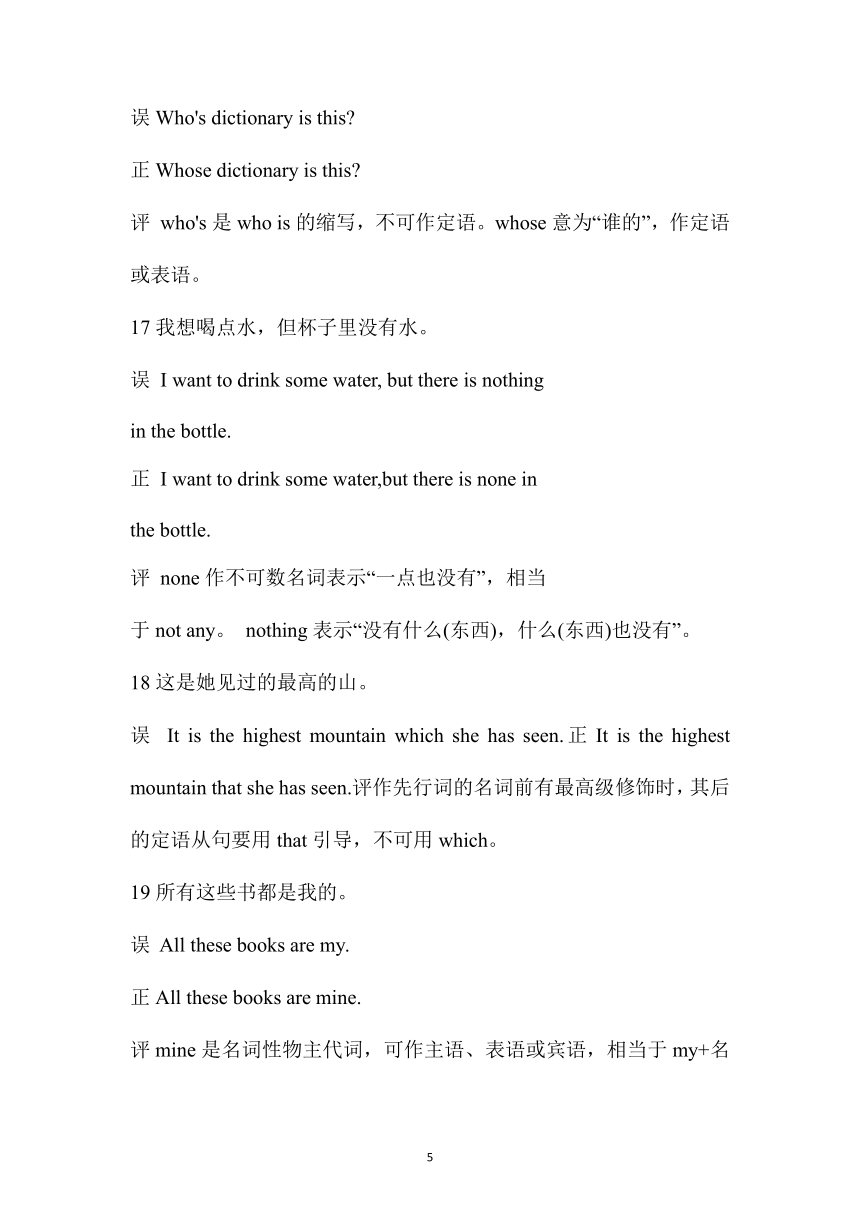
文档简介
代词正误速辨
1我们都不喜欢这部电影。
误We all don't like the film.
误All of us don't like the film.
正None of us like the film.
评表示“我们都不”要用None of us...。
2 琳达,她是莉莉。
误 Linda,she is Lily.
正 Linda, this is Lily.
评 用英语介绍双方相识时,常用“this is.…”结构。
3我不能把他一个人留下。
误 I can't leave him himself.
正I can't leave him by himself.
评leave sb.by himself表示“把某人独个儿留
下”,为习惯搭配。
4 是他写的那封信。
误It's him who wrote the letter.
正It's he who wrote the letter.
评 在正式场合,be动词后要用代词的主格形式,在口语中或在非正式场合可用代词的宾格形式。
5那是什么?一那是椅子。
误 What's that —That is a chair.
正 What's that —It is a chair.
评 由this或that表示的问句,回答时要用it。it不译为“它”,而译为“这”或“那”。
6我认为告诉你他们之间的区别很重要。
误I think important to tell you the difference
between them.
正I think it important to tell you the difference
between them.
评 think,find,feel等动词后常用it作形式宾语,而把真正宾语不定式后置。
7这个书包不是我的,是她的。
误This bag is not mine. It's her.
正This bag is not mine.It's hers.
评 mine,ours,hers等名词性物主代词,可单独使
用。my,her,our等形容词性物主代词,不可单
独使用,后要跟具体的人或物。
8这是谁的钢笔?一是汤姆的。
误 Whose pen is it —Its Tom's.
正 Whose pen is it —It's Tom's.
评its是it的所有格形式,作定语。it's是itis的缩写。
9谁能回答这个问题?我能!
误 Who can answer the question I!
正Who can answer the question Me!
评主格人称代词(I,we等)通常不单独使用,在简单回答中,一般用宾格人称代词。
10那些是什么?一那些是鸡蛋。
误 What are those —Those are eggs.
正What are those —They are eggs.
评由these或those引起的问句,回答时要用
they。
11 他们中谁会说英语?
误Who of them can speak English
正Which of them can speak English
评 which可指人或物,表示一定范围内的“哪一个,谁”。
12她母亲是一位教师。
误She mother is a teacher.
正Her mother is a teacher.
评“她母亲”要用代词所有格her,不可用代词主格。
13任何人都不能摘这些花。
误Anybody can not pick these flowers.正Nobody can pick these flowers.
评 anybody,anyone和anything用在肯定句中作主语,不可在否定句中作主语。nobody,no one和
nothing用于否定句中作主语。
14谁迟到了?一我想是玛丽。
误 Who is absent —I think she is Mary.
正Who is absent —I think it's Mary.
评 回答Who is absent Who's that等类似问句时,
如果不能肯定是“谁”,常用it代替人。
15他们哪一个也不知道答案。
误Each of them doesn't know the answer.正None of them knows the answer.
评 each作主语时,只用于肯定句,不可用于否定句。
16这是谁的词典?
误Who's dictionary is this
正Whose dictionary is this
评 who's是who is的缩写,不可作定语。whose意为“谁的”,作定语或表语。
17我想喝点水,但杯子里没有水。
误 I want to drink some water, but there is nothing
in the bottle.
正 I want to drink some water,but there is none in
the bottle.
评 none作不可数名词表示“一点也没有”,相当
于not any。 nothing表示“没有什么(东西),什么(东西)也没有”。
18这是她见过的最高的山。
误 It is the highest mountain which she has seen.正It is the highest mountain that she has seen.评作先行词的名词前有最高级修饰时,其后的定语从句要用that引导,不可用which。
19所有这些书都是我的。
误 All these books are my.
正All these books are mine.
评mine是名词性物主代词,可作主语、表语或宾语,相当于my+名词。
20就是在南京,她第一次遇见了他。
误 It was in Nanjing where she first met him.正It was in Nanjing that she first met him.评在“It is..that”强调结构中,无论强调地点、时间或人,均用that引导,不用where,which等。
21这是艾丽丝的钥匙,请交给她。
误This is Alice's key. Please give her it.
正 This is Alice's key. Please give it to her.
评give可带双宾语。如果直接宾语代词是指物的it或them,只能说give it/them to sb.;如果直接宾语是名词,则可用give me the key或give the key to me。
22我要说的就是:多注意你的发音。
误What I want to say is that: Pay more attention to your pronunciation.
正What I want to say is this: Pay more attention to your pronunciation.
评 this用于指代下面将要提及的事,that则指代上面已提到过的事。
23他们所有人都喜欢这部电影。
误All them like the film.
正All of them like the film.
评 all不可直接修饰代词,要用“all of+代词宾格”结构。
24他通常在星期天做家务。
误He usually does his housework on Sunday.正He usually does housework on Sunday.
评“做家务”要说do housework,不可加one's。
25她本人和她的儿子都受了伤。
误Herself and her son were hurt.
正She and her son were hurt.
评反身代词用于表示强调的场合。
26 玛丽穿着同莉莉一样的裙子。
误 Mary wears the same skirt that Lily wears.正Mary wears the same skirt as Lily wears.评 the same...as表示“同…·…一样的”,但两者不是同一物,the same..that则表示两者为同一物。
27你父亲是干什么的?一他是教师。误Who is your father —He is a teacher.正What is your father —He is a teacher.
正What does your father do —He is a teacher.
28 这个篮子里的苹果比那个篮子里的苹果大。误The apples in this basket are bigger than that in
that basket.
正The apples in this basket are bigger than those
in that basket.
评those和that均可指代前面已提到过的名词.
those指代复数名词,that指代单数名词或不可
数名词。
29他自学英语。
误 He taught him English.
正 He taught himself English.
评当主语与宾语为同一人时,要用反身代词。
30他们两人,哪一个都会放风筝。误Any of them can fly a kite.
正 Either of them can fly a kite.
评either表示“两个中的任何一个”;any表示
“3个或3个以上中的任何一个”。
31班上人人都喜欢运动。
误Everyone in the class are fond of sports.正Everyone in the class is fond of sports.
评everyone, everybody. everything, anyone,somebody等代词作主语时,谓语动词用单数形
式。
32 他打了她的脸。
误He hit her in her face.
正He hit her in the face.
评“打某人的脸”,要用hit sb. in the face,习惯表达。
33这幅画多美啊!
误How a beautiful picture it is!
正What a beautiful picture it is!
正How beautiful the picture is!
评 what引导感叹句修饰名词,名词前可有其他形容词修饰。how引导感叹句修饰形容词、副词或动词。
34 我有一块手表,但是几天前弄丢了。
误 Ihad a watch but I lost this a few days ago.正I had a watch but I lost it a few days ago.评 指代前面已提到过的单数名词,要用it,不用this。
35 我有些重要的事要告诉你。
误I have important something to tell you.
正 I have something important to tell you.
评 修饰不定代词something, nothing,anything,
everything等的形容词,要后置。
36 我的雨伞丢了,我要再买一把。
误I've lost my umbrella, I want to buy it again.正I've lost my umbrella, I want to buy one again.评one用于泛指,代替同一名称的另一件东西,两者不是同一物。
37 他自己洗衣服。
误Himself washed the clothes.
正He washed the clothes himself.
评 反身代词通常不作主语,而作主语或宾语的同位语,也可作动词宾语或介词宾语,常表示强调。
38 她昨天什么也没有吃。
误 She didn't eat something yesterday.
正She didn't eat anything yesterday.
评 something用于肯定句,anything用于否定句和疑问句。
39我没有词典,得买一本。
误 I haven't got a dictionary and have to buy that.正I haven't got a dictionary and have to buy one.评 表示泛指的“a/an+名词”常用one代替,表示特指的“the+名词”常用that代替。
40 那是我自己的房间。
误 That's myself room.
正 That's my own room.
评 反身代词myself,ourselves等不可作定语。
41 一个人应随时向别人学习。
误 Someone should always be ready to learn from
others.
正 One should always be ready to learn from
others.
评one表示“一个人,任何人”,为泛指,包括说话人在内。someone表示“某人,有人”。
42 她在晚会上玩得很高兴。
误 She enjoyed her at the party.
正 She enjoyed herself at the party.
评 enjoy oneself表示“过得快活,玩得快活”,要
用反身代词作宾语。
43 每个人都尽了全力。
误Everybody has done their best.
正Everybody has done his best.
评 everybody为单数,应用his保持一致。
44这两扇窗子都开着。
误The windows both are open.
正The windows are both open.
评both作同位语时,一般要放在be动词、助动词、情态动词后,行为动词前。如:They both joined the army.(他们两人都参了军。)Wemust both read the book again.(我们两人都得把这本书再读一遍。)
【提示】all用作同位语时的位置与both相同。
45汽车来了,不是吗?
误There comes the bus,doesn't there
正There comes the bus, doesn't it
评there be句型表示“存在”时,其附加问句仍
用there引导。
46 你怎样处理这些旧书呢?
误How will you do with these old books 正What will you do with these old books
评 do with意为“处理,对付”,do是及物动词,应有宾语,故要用what,不用how。
47所有这样的工具都是手工做的。误Such all tools are made by hand.正All such tools are made by hand.
评指示代词such应放在any,one,few,some,all,
no等修饰语后。
48 她昨天收到了他的来信。
误She heard from his letter yesterday.正She heard from him yesterday.
正She received his letter yesterday.
评“收到来信”可以说hear from sb.或receive
sb.'s letter。
49我昨晚9点钟做完了家庭作业。
误 I finished homework at nine o'clock last night.正 I finished my homework at nine o'clock last
night.
评 do one's homework和finish one's homework为
固定表达。
50 他们几个人谁也没爬那座山。
误 Neither of them climbed the mountain.正 None of them climbed the mountain.
评 neither表示“两者都不”;none指“3个或3个以上都不”。
51 中国有多少人口?
误How many is the population of China 误How much is the population of China 正What's the population of China
评 问“多少人口”要用What's the population.. 或How big is the population... 不可用how many或how much。
52她的父母是医生。
误Her father and her mother are doctors.
正 Her father and mother are doctors.
正Her parents are doctors.
评and连接的两个名词,关系密切时,常共用一个冠词或代词,如果关系不密切,则每个名词前均要用冠词或代词。
53两个男孩都在房间里。
误Either of the boys are in the room.正Either of the boys is in the room.
评“either of,neither of+复数名词或代词”作主语时,谓语动词用单数。
54我和莉莉在同一班上。
误Iand Lily are in the same class.正Lily and I are in the same class.
评出于礼貌,英语中通常把you放在最前面,把I放在最后。
55那里没有人,是吗?
误 Nobody is there, is anybody
正Nobody is there,are they
评nobody作陈述句的主语时,其反意疑问句通
常要用they。
56他说:“我知道答案。”
误 He said that, “I know the answer.”
正He said, “I know the answer.”
评 在直接引语中,不用连接词that,在间接引语
中才用that。
(
1
)
1我们都不喜欢这部电影。
误We all don't like the film.
误All of us don't like the film.
正None of us like the film.
评表示“我们都不”要用None of us...。
2 琳达,她是莉莉。
误 Linda,she is Lily.
正 Linda, this is Lily.
评 用英语介绍双方相识时,常用“this is.…”结构。
3我不能把他一个人留下。
误 I can't leave him himself.
正I can't leave him by himself.
评leave sb.by himself表示“把某人独个儿留
下”,为习惯搭配。
4 是他写的那封信。
误It's him who wrote the letter.
正It's he who wrote the letter.
评 在正式场合,be动词后要用代词的主格形式,在口语中或在非正式场合可用代词的宾格形式。
5那是什么?一那是椅子。
误 What's that —That is a chair.
正 What's that —It is a chair.
评 由this或that表示的问句,回答时要用it。it不译为“它”,而译为“这”或“那”。
6我认为告诉你他们之间的区别很重要。
误I think important to tell you the difference
between them.
正I think it important to tell you the difference
between them.
评 think,find,feel等动词后常用it作形式宾语,而把真正宾语不定式后置。
7这个书包不是我的,是她的。
误This bag is not mine. It's her.
正This bag is not mine.It's hers.
评 mine,ours,hers等名词性物主代词,可单独使
用。my,her,our等形容词性物主代词,不可单
独使用,后要跟具体的人或物。
8这是谁的钢笔?一是汤姆的。
误 Whose pen is it —Its Tom's.
正 Whose pen is it —It's Tom's.
评its是it的所有格形式,作定语。it's是itis的缩写。
9谁能回答这个问题?我能!
误 Who can answer the question I!
正Who can answer the question Me!
评主格人称代词(I,we等)通常不单独使用,在简单回答中,一般用宾格人称代词。
10那些是什么?一那些是鸡蛋。
误 What are those —Those are eggs.
正What are those —They are eggs.
评由these或those引起的问句,回答时要用
they。
11 他们中谁会说英语?
误Who of them can speak English
正Which of them can speak English
评 which可指人或物,表示一定范围内的“哪一个,谁”。
12她母亲是一位教师。
误She mother is a teacher.
正Her mother is a teacher.
评“她母亲”要用代词所有格her,不可用代词主格。
13任何人都不能摘这些花。
误Anybody can not pick these flowers.正Nobody can pick these flowers.
评 anybody,anyone和anything用在肯定句中作主语,不可在否定句中作主语。nobody,no one和
nothing用于否定句中作主语。
14谁迟到了?一我想是玛丽。
误 Who is absent —I think she is Mary.
正Who is absent —I think it's Mary.
评 回答Who is absent Who's that等类似问句时,
如果不能肯定是“谁”,常用it代替人。
15他们哪一个也不知道答案。
误Each of them doesn't know the answer.正None of them knows the answer.
评 each作主语时,只用于肯定句,不可用于否定句。
16这是谁的词典?
误Who's dictionary is this
正Whose dictionary is this
评 who's是who is的缩写,不可作定语。whose意为“谁的”,作定语或表语。
17我想喝点水,但杯子里没有水。
误 I want to drink some water, but there is nothing
in the bottle.
正 I want to drink some water,but there is none in
the bottle.
评 none作不可数名词表示“一点也没有”,相当
于not any。 nothing表示“没有什么(东西),什么(东西)也没有”。
18这是她见过的最高的山。
误 It is the highest mountain which she has seen.正It is the highest mountain that she has seen.评作先行词的名词前有最高级修饰时,其后的定语从句要用that引导,不可用which。
19所有这些书都是我的。
误 All these books are my.
正All these books are mine.
评mine是名词性物主代词,可作主语、表语或宾语,相当于my+名词。
20就是在南京,她第一次遇见了他。
误 It was in Nanjing where she first met him.正It was in Nanjing that she first met him.评在“It is..that”强调结构中,无论强调地点、时间或人,均用that引导,不用where,which等。
21这是艾丽丝的钥匙,请交给她。
误This is Alice's key. Please give her it.
正 This is Alice's key. Please give it to her.
评give可带双宾语。如果直接宾语代词是指物的it或them,只能说give it/them to sb.;如果直接宾语是名词,则可用give me the key或give the key to me。
22我要说的就是:多注意你的发音。
误What I want to say is that: Pay more attention to your pronunciation.
正What I want to say is this: Pay more attention to your pronunciation.
评 this用于指代下面将要提及的事,that则指代上面已提到过的事。
23他们所有人都喜欢这部电影。
误All them like the film.
正All of them like the film.
评 all不可直接修饰代词,要用“all of+代词宾格”结构。
24他通常在星期天做家务。
误He usually does his housework on Sunday.正He usually does housework on Sunday.
评“做家务”要说do housework,不可加one's。
25她本人和她的儿子都受了伤。
误Herself and her son were hurt.
正She and her son were hurt.
评反身代词用于表示强调的场合。
26 玛丽穿着同莉莉一样的裙子。
误 Mary wears the same skirt that Lily wears.正Mary wears the same skirt as Lily wears.评 the same...as表示“同…·…一样的”,但两者不是同一物,the same..that则表示两者为同一物。
27你父亲是干什么的?一他是教师。误Who is your father —He is a teacher.正What is your father —He is a teacher.
正What does your father do —He is a teacher.
28 这个篮子里的苹果比那个篮子里的苹果大。误The apples in this basket are bigger than that in
that basket.
正The apples in this basket are bigger than those
in that basket.
评those和that均可指代前面已提到过的名词.
those指代复数名词,that指代单数名词或不可
数名词。
29他自学英语。
误 He taught him English.
正 He taught himself English.
评当主语与宾语为同一人时,要用反身代词。
30他们两人,哪一个都会放风筝。误Any of them can fly a kite.
正 Either of them can fly a kite.
评either表示“两个中的任何一个”;any表示
“3个或3个以上中的任何一个”。
31班上人人都喜欢运动。
误Everyone in the class are fond of sports.正Everyone in the class is fond of sports.
评everyone, everybody. everything, anyone,somebody等代词作主语时,谓语动词用单数形
式。
32 他打了她的脸。
误He hit her in her face.
正He hit her in the face.
评“打某人的脸”,要用hit sb. in the face,习惯表达。
33这幅画多美啊!
误How a beautiful picture it is!
正What a beautiful picture it is!
正How beautiful the picture is!
评 what引导感叹句修饰名词,名词前可有其他形容词修饰。how引导感叹句修饰形容词、副词或动词。
34 我有一块手表,但是几天前弄丢了。
误 Ihad a watch but I lost this a few days ago.正I had a watch but I lost it a few days ago.评 指代前面已提到过的单数名词,要用it,不用this。
35 我有些重要的事要告诉你。
误I have important something to tell you.
正 I have something important to tell you.
评 修饰不定代词something, nothing,anything,
everything等的形容词,要后置。
36 我的雨伞丢了,我要再买一把。
误I've lost my umbrella, I want to buy it again.正I've lost my umbrella, I want to buy one again.评one用于泛指,代替同一名称的另一件东西,两者不是同一物。
37 他自己洗衣服。
误Himself washed the clothes.
正He washed the clothes himself.
评 反身代词通常不作主语,而作主语或宾语的同位语,也可作动词宾语或介词宾语,常表示强调。
38 她昨天什么也没有吃。
误 She didn't eat something yesterday.
正She didn't eat anything yesterday.
评 something用于肯定句,anything用于否定句和疑问句。
39我没有词典,得买一本。
误 I haven't got a dictionary and have to buy that.正I haven't got a dictionary and have to buy one.评 表示泛指的“a/an+名词”常用one代替,表示特指的“the+名词”常用that代替。
40 那是我自己的房间。
误 That's myself room.
正 That's my own room.
评 反身代词myself,ourselves等不可作定语。
41 一个人应随时向别人学习。
误 Someone should always be ready to learn from
others.
正 One should always be ready to learn from
others.
评one表示“一个人,任何人”,为泛指,包括说话人在内。someone表示“某人,有人”。
42 她在晚会上玩得很高兴。
误 She enjoyed her at the party.
正 She enjoyed herself at the party.
评 enjoy oneself表示“过得快活,玩得快活”,要
用反身代词作宾语。
43 每个人都尽了全力。
误Everybody has done their best.
正Everybody has done his best.
评 everybody为单数,应用his保持一致。
44这两扇窗子都开着。
误The windows both are open.
正The windows are both open.
评both作同位语时,一般要放在be动词、助动词、情态动词后,行为动词前。如:They both joined the army.(他们两人都参了军。)Wemust both read the book again.(我们两人都得把这本书再读一遍。)
【提示】all用作同位语时的位置与both相同。
45汽车来了,不是吗?
误There comes the bus,doesn't there
正There comes the bus, doesn't it
评there be句型表示“存在”时,其附加问句仍
用there引导。
46 你怎样处理这些旧书呢?
误How will you do with these old books 正What will you do with these old books
评 do with意为“处理,对付”,do是及物动词,应有宾语,故要用what,不用how。
47所有这样的工具都是手工做的。误Such all tools are made by hand.正All such tools are made by hand.
评指示代词such应放在any,one,few,some,all,
no等修饰语后。
48 她昨天收到了他的来信。
误She heard from his letter yesterday.正She heard from him yesterday.
正She received his letter yesterday.
评“收到来信”可以说hear from sb.或receive
sb.'s letter。
49我昨晚9点钟做完了家庭作业。
误 I finished homework at nine o'clock last night.正 I finished my homework at nine o'clock last
night.
评 do one's homework和finish one's homework为
固定表达。
50 他们几个人谁也没爬那座山。
误 Neither of them climbed the mountain.正 None of them climbed the mountain.
评 neither表示“两者都不”;none指“3个或3个以上都不”。
51 中国有多少人口?
误How many is the population of China 误How much is the population of China 正What's the population of China
评 问“多少人口”要用What's the population.. 或How big is the population... 不可用how many或how much。
52她的父母是医生。
误Her father and her mother are doctors.
正 Her father and mother are doctors.
正Her parents are doctors.
评and连接的两个名词,关系密切时,常共用一个冠词或代词,如果关系不密切,则每个名词前均要用冠词或代词。
53两个男孩都在房间里。
误Either of the boys are in the room.正Either of the boys is in the room.
评“either of,neither of+复数名词或代词”作主语时,谓语动词用单数。
54我和莉莉在同一班上。
误Iand Lily are in the same class.正Lily and I are in the same class.
评出于礼貌,英语中通常把you放在最前面,把I放在最后。
55那里没有人,是吗?
误 Nobody is there, is anybody
正Nobody is there,are they
评nobody作陈述句的主语时,其反意疑问句通
常要用they。
56他说:“我知道答案。”
误 He said that, “I know the answer.”
正He said, “I know the answer.”
评 在直接引语中,不用连接词that,在间接引语
中才用that。
(
1
)
同课章节目录
- 词法
- 名词
- 动词和动词短语
- 动词语态
- 动词时态
- 助动词和情态动词
- 非谓语动词
- 冠词
- 代词
- 数词和量词
- 形容词副词及其比较等级
- 介词和介词短语
- 连词和感叹词
- 构词法
- 相似、相近词比较
- 句法
- 陈述句
- 一般疑问句和否定疑问句
- 特殊疑问句及选择疑问句
- 反意疑问句
- 存在句(There be句型)
- 宾语从句
- 定语从句
- 状语从句
- 主谓一致问题
- 简单句
- 并列句
- 复合句
- 主谓一致
- 主、表语从句
- 名词性从句
- 直接引语和间接引语
- 虚拟语气
- 感叹句
- 强调句
- 倒装句
- 祈使句
- 句子的成分
- 句子的分类
- 题型专区
- 单项选择部分
- 易错题
- 完形填空
- 阅读理解
- 词汇练习
- 听说训练
- 句型转换
- 补全对话
- 短文改错
- 翻译
- 书面表达
- 任务型阅读
- 语法填空
- 其他资料
